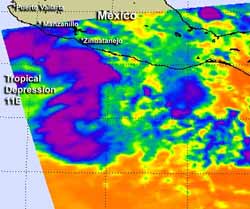NASA Gives Infrared Identification of New Eastern Pacific Tropical Depression

NASA's Aqua satellite captured an infrared image of developing System 90E on Sept. 11 at 3:47 p.m. EDT showing a very large area of strong thunderstorms (purple) on the western side of the center of circulation. System 90E organized more on Sept. 12 and was renamed Tropical Depression 11E. Credit: NASA/JPL, Ed Olsen<br>
The Atmospheric Infrared Sounder (AIRS) instrument onboard Aqua captured an infrared image of System 90E on Sept. 11 at 1947 UTC (3:47 p.m. EDT). That infrared image took the temperatures of the cloud tops and found some strong, high thunderstorms wrapped around the western side of the low pressure area's circulation, from north to south.
That area of thunderstorms had cloud top temperatures that exceeded the AIRS data -63 Fahrenheit/-52 Celsius threshold, indicating strong thunderstorms with heavy rainfall and a sign that the low was organizing. Less than 24 hours later, System 90E would be re-named Tropical Depression 11E, when the National Hurricane Center noted “It developed enough organized convection to be classified as a tropical depression.”
On Sept. 12 at 11 a.m. EDT Tropical Depression 11E had maximum sustained winds near 35 mph (55 kmh) and the National Hurricane Center noted that the depression could become a tropical storm tonight (Sept. 12) or Thursday, Sept. 13. Tropical Depression 11E was located near latitude 16.7 north and longitude 106.0 west, about 195 miles (315 km) southwest of Manzanillo, Mexico.
The depression is moving toward the west-northwest near 10 mph (17 kmh) and the National Hurricane Center expected it to continue in that direction over the next two days, moving away from the coast.
The Eastern Pacific Ocean is lagging behind the Atlantic Ocean in the development of tropical depressions this year. The fourteenth tropical depression in the Atlantic just strengthened into Tropical Storm Nadine.
Text Credit: Rob Gutro
NASA Goddard Space Flight Center, Greenbelt, Md.
Media Contact
All latest news from the category: Earth Sciences
Earth Sciences (also referred to as Geosciences), which deals with basic issues surrounding our planet, plays a vital role in the area of energy and raw materials supply.
Earth Sciences comprises subjects such as geology, geography, geological informatics, paleontology, mineralogy, petrography, crystallography, geophysics, geodesy, glaciology, cartography, photogrammetry, meteorology and seismology, early-warning systems, earthquake research and polar research.
Newest articles

Superradiant atoms could push the boundaries of how precisely time can be measured
Superradiant atoms can help us measure time more precisely than ever. In a new study, researchers from the University of Copenhagen present a new method for measuring the time interval,…

Ion thermoelectric conversion devices for near room temperature
The electrode sheet of the thermoelectric device consists of ionic hydrogel, which is sandwiched between the electrodes to form, and the Prussian blue on the electrode undergoes a redox reaction…

Zap Energy achieves 37-million-degree temperatures in a compact device
New publication reports record electron temperatures for a small-scale, sheared-flow-stabilized Z-pinch fusion device. In the nine decades since humans first produced fusion reactions, only a few fusion technologies have demonstrated…





















